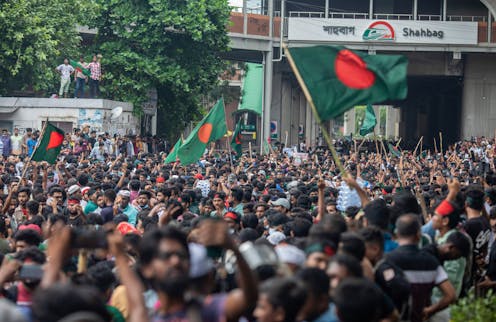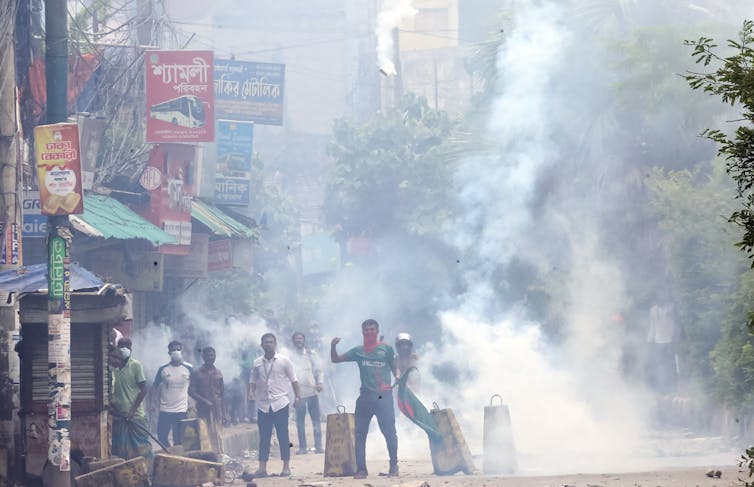Bangladesh’s protests explained: What led to PM’s ouster and the challenges that lie ahead
Military leaders have formed an interim government and promised a transition to civilian rule. Protesters who brought down the previous government are demanding nothing less.

Bangladesh’s embattled prime minister, Sheikh Hasina, fled the country on Aug. 5, 2024, after weeks of protests that have resulted in scores of deaths.
Her departure is a landmark moment, but one that has left the South Asian nation facing a power vacuum into which the army – for the time being, at least – has stepped.
To understand what led to the crisis and what could happen next, The Conversation turned to Tazreena Sajjad, an expert on Bangladeshi politics at American University’s School of International Service.
What sparked the demonstrations in Bangladesh?
The protests stem from long-running resentment over a quota system that saw 56% of government positions in Bangladesh reserved for various groups, including 30% for the descendants of freedom fighters who fought in the 1971 War of Independence.
This quota system has proved an enormous barrier to highly coveted civil service positions for the country’s large youth population, many of whom are unemployed.
It had also become a subject of controversy due to how many of those quota jobs went to supporters of the ruling Awami League party.
Under immense pressure from an earlier student mobilization over the issue, Hasina abolished the entire quota system in 2018.
But in June 2024, the country’s high court ruled that move illegal, sparking a fresh round of protests across the country.
Then, in July, Bangladesh’s public universities saw a series of walkouts by faculty and students over new pension reforms that, if implemented, would involve salary deductions.
Initially, the protests were peaceful, but an incendiary speech by Hasina – in which she suggested that the students were “rajakaar,” a term used to identify pro-Pakistan collaborators during Bangladesh’s War of Independence – inflamed tensions.
The Bangladesh Chhatra League – the armed wing of the Awami League – began attacking students with tear gas and live bullets, with support from the police. The Rapid Action Battalion, a controversial paramilitary group with a history of extrajudicial killings, torture and enforced disappearances, was also deployed.
After a video of one of the first to be killed – a university student named Abu Sayeed – circulated online, more joined the protests, leading to a further violent crackdown by police and armed groups.
It is estimated that about 266 people, mostly students, were killed in the protests, including at least 32 children.
The government closed schools and universities, imposed a curfew and cut internet and telecommunications. Meanwhile, student leaders were arrested and coerced to withdraw their list of demands.
But this only led to the declaration of a total noncooperation movement and a massive uprising of protesters demanding Hasina’s immediate resignation.
As thousands of protesters gathered for a long march to Dhaka in defiance of the curfew, the prime minister resigned and left the country.
Is there a wider context to the political unrest?
Absolutely. While attention has focused largely on the quota protests, a litany of grievances had piled up against the government.
Under Hasina’s rule, Bangladesh has seen GDP growth – but this has not translated into economic well-being for many Bangladeshis. Lack of opportunities, high unemployment rates among youth and soaring inflation have been ongoing sources of tension.
Meanwhile, despite the Awami League espousing a zero-tolerance policy towards corruption, money laundering, bribery and nepotism scandals have dogged government ministers.
And since its landslide victory in 2008, the Awami League has eroded the country’s democracy. For example, in 2011 the government ended an arrangement that allowed a 90-day caretaker administration, consisting of technocrats, to organize elections and oversee transfers of power.
Suppression of dissent has also grown. The harassment and detention of activists, opposition figures and human rights defenders have become more frequent. Meanwhile, there has been criminalization of any criticism of the government, including satire and social media posts.
Why is the 1971 war still relevant to Bangladeshi politics?
The War of Independence remains central to Bangladesh’s identity and its politics.
Its seeds were sown decades earlier in the 1947 British partition of the Indian subcontinent. This resulted in the violent division of the state of Bengal, with the eastern part becoming East Pakistan.
After partition, West Pakistan tried to maintain political and economic dominance over East Pakistan, while at the same time attempting to cultivate a singular national identity – based on their common Muslim majority populations – despite separate cultures and linguistic heritages.
Policies to marginalize Bengali – the vernacular of 56% of then East Pakistanis – and “purify” East Pakistan from Hindu influence contributed to a backlash that saw widespread student protests and growing calls for independence.
In 1971, a West Pakistani military incursion aimed at snuffing out pro-independence sentiments resulted in a genocidal war with East Pakistan that lasted nine months and resulted in the deaths of 500,000 to 3 million Bangladeshis.
The circumstances of that war have shaped Bangladesh’s politics ever since. The parties that have dominated the country’s politics, including Hasina’s Awami League, frequently politicized their War of Independence credentials. Political leaders have also used 1971 as a means of legitimizing positions, shoring up support, or delegitimizing opposition parties.
Does Hasina’s exit mark the end of Bangladesh’s political dynasties?
The resignation of Hasina signals – at least for the time being – the end of Awami League rule in Bangladesh.
Countries in South Asia, including Bangladesh, have largely been shaped by political dynasties. So the rejection of the Awami League, and the fact that many are also rejecting other established political parties – the Bangladesh Nationalist Party, Jamaat-i-Islami and the Jatiya Party – is extraordinary.
These established parties will no doubt try to regroup. While the Awami League may not be able to effectively organize in the near future given public sentiment, the others will make a concerted effort to participate in the promised forthcoming elections.
For the moment, there may be an opportunity for Bangladesh to have fresh voices and faces in politics, potentially emerging from the student movement.
What should we make of the military taking interim control?
Since Bangladesh’s independence, the army has played a huge role in shaping the political trajectory of the country.
From 1975 to 2011, Bangladesh experienced at least 29 military coups and counter-coups. It also experienced direct military rule from 1977 to 1981 and between 1981 and 1990.
Given the army’s frequent incursion into Bangladesh politics, it is not surprising that it has taken interim control of the country now.
For many Bangladeshis, this may represent some level of stability, given the political vacuum that has opened up and the uncertainty of the moment.
Student leaders, however, have made it clear they do not want military involvement in politics. Seemingly heeding this call, General Waker-uz-Zaman, the army chief of staff, has assured protesters that the army would meet their demands.
But it remains to be seen whether the military will keep its promises and hand over full authority to a civilian interim administration.
What could happen next?
It is too early to speculate what the future holds for Bangladesh – the situation is extremely fluid and unfolding by the minute.
The abrupt departure of Hasina has been a cause of relief and celebration among the millions of protesters who helped bring about an end to her rule.

Protest leaders have expressed a clear vision for an inclusive, corruption-free, democratic government. What they don’t want is an interim government that is formed without their involvement and input. Student leaders have put together a list of candidates they want to see in the interim government. Nobel laureate Muhammad Yunus has accepted a role as chief adviser. Meanwhile, Bangladesh Nationalist Party and Jamaat-i-Islami leaders are vying for positions in the interim government.
But political transitions are extremely challenging and volatile. There have been incidences of looting, arson and violence around the country, as well as attacks on the Hindu community.
Armed wings of the Islamist Jamaat-i-Islami and the Bangladesh Chhatra League are being blamed for much of the violence, which, it is alleged, is carried out to delegitimize the protest movement. In response, students and the general public have stepped in to protect minority places of worship.
Rumors and disinformation campaigns will certainly have some significant impact in a volatile situation.
Meanwhile, the enormous damage done to the country’s economy by the political turmoil and military curfew will also require attention.
Neighboring countries, particularly India, are paying a lot of attention to the volatile situation. International donors and strategic partners including the U.S., EU, and China likewise await what comes next, given Bangladesh’s regional geopolitics and the global economy.
Tazreena Sajjad does not work for, consult, own shares in or receive funding from any company or organization that would benefit from this article, and has disclosed no relevant affiliations beyond their academic appointment.
Read These Next
Medieval peasants probably enjoyed their holiday festivities more than you do
The Middle Ages weren’t as dreary and desperate as you’d think, and peasants often had weeks of…
Autocracies in transition: In 2025, Cameroon and Tanzania rulers clung to power — but look more vuln
The countries, whose respective leaders recently won widely disputed elections, offer contrasting examples…
Why are some Black conservatives drawn to Nick Fuentes?
Black Americans and white nationalists have joined forces in the past. And a number of cultural and…





